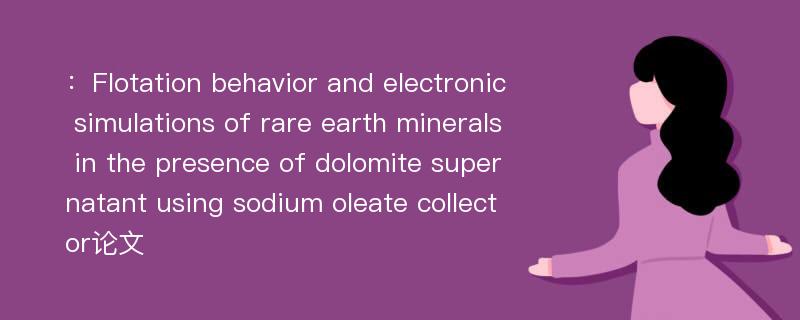
本文主要研究内容
作者(2019)在《Flotation behavior and electronic simulations of rare earth minerals in the presence of dolomite supernatant using sodium oleate collector》一文中研究指出:Common rare earth (RE) minerals, such as bastnasite and monazite, may be formed in deposits associated with carbonate gangue, such as calcite and dolomite. Sodium oleate is a widely used collector for the flotation of both RE and gangue minerals, which might, therefore, be an inefficient process due to the lack of selectivity of this collector. Since these minerals are also sparingly soluble in solution, they could release their constituent ions into the solution, which could affect the floatability of other minerals. In this study, the interactions of sodium oleate with bastn(a|¨)site and monazite in the presence of dissolved dolomite species have been investigated. Micro flotation tests were carried out to explore the effects of these dissolved species on the floatability of the RE minerals. Zeta potential measurements and XPS characterization were carried out to understand how the species affect the collector adsorption. To complement these characterizations, density functional theory (DFT) simulations were conducted to investigate the collector-mineral and collector-adsorbed species (on the mineral surface) interactions.The results show that collector-dolomite interaction energy is greater than that of collector-adsorbed species, but lower than collector-monazite interaction energy, explaining the decrease in the minerals’recovery upon exposure to the dissolved mineral species. It is also shown that oleate ions (OI-) have the strongest interaction with the minerals compared to other oleate species such as acid soap (HOI2-) and oleate dimer (Ol22-). The behavior (strength and selectivity) of sodium oleate towards RE minerals and dolomite, as compared to other RE mineral collectors (such as aromatic hydroxamate), is attributed mainly to the collector’s and the minerals’structure. The long hydrocarbon chain of sodium oleate which imparts hydrophobic characteristic to the minerals, makes it stronger collector than benzohydroxamate.Moreover, sodium oleate (with linear structure), unlike the aromatic hydroxamate, can approach the mineral easier due to lesser steric hindrance effect and higher reactivity of O involved in the interaction,making it less selective. In addition, it can interact easily with dolomite due to the presence of more exposed active sites than RE minerals.
Abstract
Common rare earth (RE) minerals, such as bastnasite and monazite, may be formed in deposits associated with carbonate gangue, such as calcite and dolomite. Sodium oleate is a widely used collector for the flotation of both RE and gangue minerals, which might, therefore, be an inefficient process due to the lack of selectivity of this collector. Since these minerals are also sparingly soluble in solution, they could release their constituent ions into the solution, which could affect the floatability of other minerals. In this study, the interactions of sodium oleate with bastn(a|¨)site and monazite in the presence of dissolved dolomite species have been investigated. Micro flotation tests were carried out to explore the effects of these dissolved species on the floatability of the RE minerals. Zeta potential measurements and XPS characterization were carried out to understand how the species affect the collector adsorption. To complement these characterizations, density functional theory (DFT) simulations were conducted to investigate the collector-mineral and collector-adsorbed species (on the mineral surface) interactions.The results show that collector-dolomite interaction energy is greater than that of collector-adsorbed species, but lower than collector-monazite interaction energy, explaining the decrease in the minerals’recovery upon exposure to the dissolved mineral species. It is also shown that oleate ions (OI-) have the strongest interaction with the minerals compared to other oleate species such as acid soap (HOI2-) and oleate dimer (Ol22-). The behavior (strength and selectivity) of sodium oleate towards RE minerals and dolomite, as compared to other RE mineral collectors (such as aromatic hydroxamate), is attributed mainly to the collector’s and the minerals’structure. The long hydrocarbon chain of sodium oleate which imparts hydrophobic characteristic to the minerals, makes it stronger collector than benzohydroxamate.Moreover, sodium oleate (with linear structure), unlike the aromatic hydroxamate, can approach the mineral easier due to lesser steric hindrance effect and higher reactivity of O involved in the interaction,making it less selective. In addition, it can interact easily with dolomite due to the presence of more exposed active sites than RE minerals.
论文参考文献
论文详细介绍
论文作者分别是来自Journal of Rare Earths的,发表于刊物Journal of Rare Earths2019年01期论文,是一篇关于,Journal of Rare Earths2019年01期论文的文章。本文可供学术参考使用,各位学者可以免费参考阅读下载,文章观点不代表本站观点,资料来自Journal of Rare Earths2019年01期论文网站,若本站收录的文献无意侵犯了您的著作版权,请联系我们删除。
